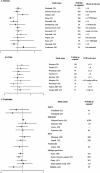Can environmental or occupational hazards alter the sex ratio at birth? A systematic review
- PMID: 24149027
- PMCID: PMC3168220
- DOI: 10.3402/ehtj.v4i0.7109
Can environmental or occupational hazards alter the sex ratio at birth? A systematic review
Abstract
More than 100 studies have examined whether environmental or occupational exposures of parents affect the sex ratio of their offspring at birth. For this review, we searched Medline and Web of Science using the terms 'sex ratio at birth' and 'sex ratio and exposure' for all dates, and reviewed bibliographies of relevant studies to find additional articles. This review focuses on exposures that have been the subject of at least four studies including polychlorinated biphenyls (PCBs), dioxins, pesticides, lead and other metals, radiation, boron, and g-forces. For paternal exposures, only dioxins and PCBs were consistently associated with sex ratios higher or lower than the expected 1.06. Dioxins were associated with a decreased proportion of male births, whereas PCBs were associated with an increased proportion of male births. There was limited evidence for a decrease in the proportion of male births after paternal exposure to DBCP, lead, methylmercury, non-ionizing radiation, ionizing radiation treatment for childhood cancer, boron, or g-forces. Few studies have found higher or lower sex ratios associated with maternal exposures. Studies in humans and animals have found a reduction in the number of male births associated with lower male fertility, but the mechanism by which environmental hazards might change the sex ratio has not yet been established.
Keywords: PCBs; boron; dioxins; environmental; g-forces; metals; occupational; pesticides; radiation; sex ratio.
Figures



Similar articles
-
Environmental hazards: evidence for effects on child health.J Toxicol Environ Health B Crit Rev. 2007 Jan-Mar;10(1-2):3-39. doi: 10.1080/10937400601034563. J Toxicol Environ Health B Crit Rev. 2007. PMID: 18074303 Review.
-
Environmental factors associated with a spectrum of neurodevelopmental deficits.Ment Retard Dev Disabil Res Rev. 2002;8(3):188-97. doi: 10.1002/mrdd.10033. Ment Retard Dev Disabil Res Rev. 2002. PMID: 12216063 Review.
-
Epidemiologic evidence of relationships between reproductive and child health outcomes and environmental chemical contaminants.J Toxicol Environ Health B Crit Rev. 2008 May;11(5-6):373-517. doi: 10.1080/10937400801921320. J Toxicol Environ Health B Crit Rev. 2008. PMID: 18470797 Review.
-
Environmental exposure to polychlorinated biphenyls (PCBs) and dioxins. Consequences for longterm neurological and cognitive development of the child lactation.Adv Exp Med Biol. 2000;478:271-87. Adv Exp Med Biol. 2000. PMID: 11065080 Review.
-
Environmental exposure to dioxins and polychlorinated biphenyls reduce levels of gonadal hormones in newborns: results from the Duisburg cohort study.Int J Hyg Environ Health. 2008 Mar;211(1-2):30-9. doi: 10.1016/j.ijheh.2007.04.005. Epub 2007 Jul 30. Int J Hyg Environ Health. 2008. PMID: 17660003
Cited by
-
Offspring sex ratio of Iranian dentists.Environ Health Prev Med. 2016 Nov;21(6):446-449. doi: 10.1007/s12199-016-0546-y. Epub 2016 Jun 21. Environ Health Prev Med. 2016. PMID: 27329277 Free PMC article.
-
Response to W. Kramer: The human sex odds at birth after the atmospheric atomic bomb tests, after Chernobyl, and in the vicinity of nuclear facilities: comment (doi:10.1007/s11356-011-0644-8).Environ Sci Pollut Res Int. 2012 May;19(4):1335-40. doi: 10.1007/s11356-012-0845-9. Epub 2012 Mar 16. Environ Sci Pollut Res Int. 2012. PMID: 22421798
-
Changes in sex ratio at birth among immigrant groups in Sweden.Genus. 2018;74(1):13. doi: 10.1186/s41118-018-0036-8. Epub 2018 Sep 3. Genus. 2018. PMID: 30237588 Free PMC article.
-
Multigenerational and Transgenerational Effects of Dioxins.Int J Mol Sci. 2019 Jun 17;20(12):2947. doi: 10.3390/ijms20122947. Int J Mol Sci. 2019. PMID: 31212893 Free PMC article. Review.
-
Sex ratios at birth vary with environmental harshness but not maternal condition.Sci Rep. 2019 Jun 21;9(1):9066. doi: 10.1038/s41598-019-45316-7. Sci Rep. 2019. PMID: 31227750 Free PMC article.
References
-
- Marcus M, Kiely J, Xu F, McGeehin M, Jackson R, Sinks T. Changing sex ratio in the United States, 1969–1995. Fertil Steril. 1998;70:270–3. - PubMed
-
- Mathews TJ, Hamilton BE. Trend analysis of the sex ratio at birth in the United States. Natl Health Stat Report. 2005;53:1–17. - PubMed
-
- Agresti A, Coull BA. Approximate is better than ‘exact’ for interval estimation of binomial proportions. Am Statistician. 1998;52:119–26.
-
- Vollset SE. Confidence intervals for a binomial proportion. Stat Med. 1993;12:809–24. - PubMed
-
- Chang BL, Robbins WA, Wei F, Xun L, Wu G, Li N, et al. Boron workers in China: Exploring work and lifestyle factors related to boron exposure. AAOHN J. 2006;54:435–43. - PubMed
Grants and funding
LinkOut - more resources
Full Text Sources
